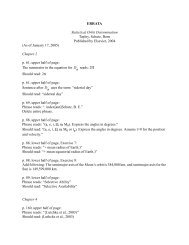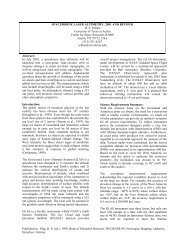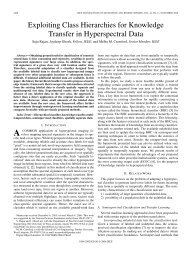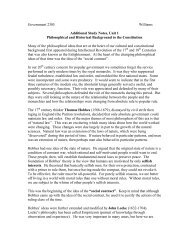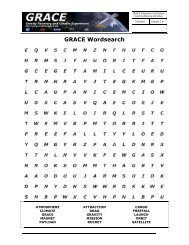(GLAS) PRECISION ATTITUDE DETERMINATION - Center for ...
(GLAS) PRECISION ATTITUDE DETERMINATION - Center for ...
(GLAS) PRECISION ATTITUDE DETERMINATION - Center for ...
Create successful ePaper yourself
Turn your PDF publications into a flip-book with our unique Google optimized e-Paper software.
third star is considered in a position to <strong>for</strong>m an isosceles triangle with base stars. It iscomputed by=jD 13m; D 23m j (4.11)which means the distance dierence between two sides of triangles other than the baseline. In other words, if the third star, 3, is located at a position to make the right sideof Equation 4.11 less than , the three identied stars are considered to <strong>for</strong>m an isoscelestriangle. These stars are regarded as possible misidentication cases and are abandoned.The identication processing is resumed in order to nd another group of stars which donot construct the isosceles triangle dened by Equation 4.11.Table 4.1 shows that all the star tracker measurement frames are reported as identied(indicated by 100%) if the isosceles triangle <strong>for</strong>med by thethree stars is simply regardedas a correct identication ( = 0). However, the misidentication occurred in some framesas indicated in the last column of the Table 4.1, except <strong>for</strong> the case with 45 initial rightascension, . For example, 0 initial contains 167 misidentied frames, which is0:3% ofthe reported identied frames. Computed results show that when the angle is increased,the occurrence of the misidentication is decreased and nally disappears. There are morereductions in the total numberofidentied frames (see the seventh column in Table 4.1)than the number of misidentied ones (the eighth column). This clearly indicates thatthe elimination of the misidentication source results in the removal of some correctlyidentied frames. Table 4.1 also shows that the number of frames with ve identiedstars (the sixth column) increases as increases. This means that the misidenticationin some frames hinders the determination of correct star matches. The lowest probabilityof successfully identifying stars without misidentication was 98:59% in the simulation.Even though this result is undoubtedly promising, further star identication tests (andnecessary improvements) should be carried out with more background stars in which themagnitude range covers up to eighth or ninth.4.2 Direct Match Technique (DMT)4.2.1 AlgorithmThe requirement of more than two stars as well as the relatively high possibility of themisidentication when only three stars are present in the star tracker FOV were pointedout as shortcomings of the PMA. The DMT enables us to identify the stars when the FOVcontains only one or two stars. Once the <strong>GLAS</strong> attitude determination is initialized anddetermines attitude in the required accuracy, the DMT can identify almost all stars observedby the FOV. The prediction of attitude can be achieved by applying the kinematicequation of attitude quaternions, Equation 2.11. Alternatively, the quaternions obtainedby the real time on-board attitude determination can be used. The accuracy requirement<strong>for</strong> real time is 10-20 arcseconds(1). Figure 4.6 illustrates the relations of the coordinateframes in the DMT. The star tracker observes up to six stars at a measurement time. Ifeither the predicted or the real time attitude is known, the star positions will be trans<strong>for</strong>medfrom the SCF to the CRF (the observed CRF in Figure 4.6). If either the predicted42



